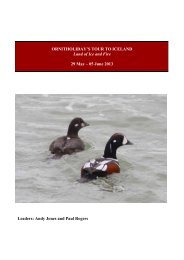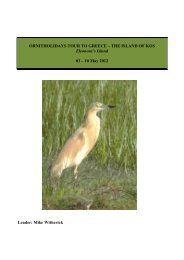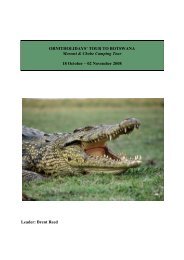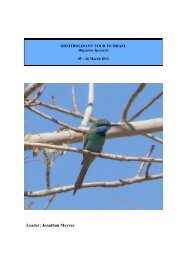Download 2014 Brochure (.pdf) - Ornitholidays
Download 2014 Brochure (.pdf) - Ornitholidays
Download 2014 Brochure (.pdf) - Ornitholidays
You also want an ePaper? Increase the reach of your titles
YUMPU automatically turns print PDFs into web optimized ePapers that Google loves.
E T H I O P I A<br />
Ethiopia<br />
Undiscovered Africa<br />
Friday 26 September – Friday 10 October <strong>2014</strong><br />
Leaders: Gabor Orban and Nigel Jones<br />
<strong>2014</strong> Cost £3,299 single room supplement £220<br />
ETHIOPIA<br />
Addis Ababa<br />
Awasa<br />
Yabello<br />
Wondo<br />
Guenet<br />
Awash<br />
National<br />
Park<br />
Lake Langano<br />
Goba<br />
T<br />
he first <strong>Ornitholidays</strong>’ group visited Ethiopia in 1971, and we have been adding to our expertise in leading tours here ever since. Our present<br />
itinerary is remarkably similar to our earlier ones and succeeds in covering a wide range of habitats. We visit the highland plateau around Addis,<br />
the Rift Valley lakes and acacia forests, the Bale Mountain National Park and finally the savannah of the Awash National Park. In all areas the scenery<br />
is spectacular, the birdlife plentiful and unusually approachable – a photographer’s dream. Many of the bird species will be familiar to those who have<br />
visited other parts of East Africa, but we will also be concentrating on the endemics that we could encounter on this itinerary. Ethiopia has emerged<br />
well from its recent political problems with the tourist infrastructure intact, yet we will generally find that we have our birding areas to ourselves! The<br />
country has a wonderful climate with plenty of sunshine and cool breezes, even in the Rift Valley. One particular advantage of Ethiopia is that, (due<br />
to the absence of dangerous animals), we are allowed to wander through the national parks on foot. This will be <strong>Ornitholidays</strong>’ 23rd tour to the country.<br />
Travel with Gabor and Nigel and see why <strong>Ornitholidays</strong> led the pioneering birdwatching tours to explore this fascinating country.<br />
ITINERARY<br />
Days 1 to 3<br />
We leave London on an evening scheduled flight<br />
for Addis Ababa, where we arrive the next<br />
morning and transfer to our hotel for a stay of two<br />
nights. Addis is situated at 2,400m (8,000ft) and<br />
has a delightful, refreshing climate. The city's<br />
gardens attract such species as Dusky Turtle and<br />
Red-eyed Doves, Nyanza Swift, Common Fiscal,<br />
Olive Thrush, Tacazze Sunbird and Baglafecht<br />
Weaver. In the afternoon, we visit Gefarsa<br />
Reservoir, on whose shores we may encounter<br />
our first Ethiopian endemics, such as Whitecollared<br />
Pigeon and Black-headed Siskin. The<br />
next full day is spent visiting the Blue Nile Gorge<br />
at Debre Libanos. We climb north out of the city<br />
and cross the Solulta Plateau. We stop among<br />
the grasslands that are attractive to a variety of<br />
passerines, such as Red-throated Pipit,<br />
Isabelline and Red-breasted Wheatears. We<br />
hope to see two special endemics, the Wattled<br />
Ibis and the Blue-winged Goose. The wagtail-like<br />
Abyssinian Longclaw is likely here too. At Debre<br />
Libanos, the plateau comes to an abrupt halt as<br />
the vast vista of a deep gorge opens up below<br />
us. Lammergeiers, White-backed and Rüppell's<br />
Vultures and Lanner Falcons all occur here. On<br />
the crags, we will look for the endemic Rüppell's<br />
Chat and White-billed Starling. Family groups of<br />
Gelada Baboons are also a feature of the gorge.<br />
The little-known Erckel’s Francolin is also found<br />
here. The large monastery at Debre Libanos<br />
owns and protects a patch of interesting old<br />
evergreen forest, where such species as African<br />
Paradise and Abyssinian Slaty Flycatchers,<br />
Golden-backed Woodpecker and Whitecheeked<br />
Turaco can be found.<br />
Days 4 & 5<br />
Today we head towards Lake Langano. We may<br />
see the Afar tribesmen herding their camels or<br />
the first flocks of Common Cranes now arriving<br />
to winter in the harvested pastures of the local<br />
grain, tef. We stop by shallow lakes where<br />
nesting Kittlitz’s Plovers are joined by various<br />
wintering Palearctic waders. At Lake Zwai, we<br />
stop for lunch and a birding extravaganza on the<br />
shore. Large numbers of White Pelican, Marabou<br />
Stork, Spur-winged Geese, White-faced<br />
Whistling-Duck, African Fish-Eagle and African<br />
Jacana are likely, together with lesser numbers<br />
of Grey-headed Gull, African Pygmy-Goose and<br />
Yellow-billed Stork. Lesser Jacanas are<br />
sometimes seen here. For two nights we stay<br />
near the shores of Lake Langano, a beautiful<br />
Wattled Crane<br />
52<br />
For a previous tour report or further information please call: 01794 519445








